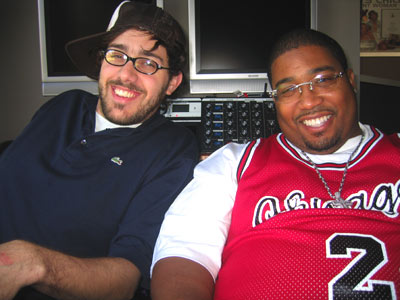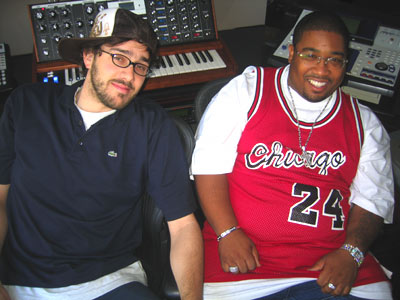Analog Dialog: It's a Family Affair
Crankin’ out the Hits: Producer Corey Rooney and Engineer Peter Wade
 |
|
Peter Wade and Corey Rooney Have a Lot to Smile About
|
I had met Peter in New York at AES but must admit, I was pretty intimidated by the promise of interviewing Rooney. This guy has more platinum records than… I don’t know… a lot of people ;-) He’s a major player in the Sony Music and R&B Empire, but when I spoke to him, I was pleasantly relieved; he couldn’t be a nicer guy.
“Wade’s preferred signal chain for Tamar’s vocals is a Neumann U87 thru the 6176 directly into Pro Tools.”
Rooney grew up with music in his blood, bangin’ on the ivories before he could walk. His parent’s R&B group, the Exciters, charted a big hit in the early 60’s with the song “Tell Him”. Later, his parents toured the oldies circuit with twelve-year-old Rooney on keyboards, his brother on drums and sister singing backup. His father, Herb Rooney, produced a number of big acts such as the Isley Brothers. “They would rehearse in our living room, so I couldn’t wait to get home from school, I was always excited to see who was out to my house that day. I see my kids experiencing the same thing. My daughter came home the other day and Usher was here... It’s cool.”
Rooney has been able to set himself up with a home studio in the expanded pool house of his Long Island home and does everything there. “I do everything at home now at this point, even recording drums. My kids are incredible and it’s great life, they come home from school and bring their homework into the studio. It feels like I felt when I was younger.” I bet his daughter is pretty popular at school, especially when ‘Jenny from the block’ drops by…
Rooney started working at the hip-hop label, Uptown Records, with Puffy and L.A. Reid in the early nineties and scored with the first Mary J. Blige album, “What’s the 411?” Critics acclaimed this album as “a powerful combination of modern R&B with an edgy rap sound”. Rooney and his longtime writing partner Mark Morales wrote her huge single, “Real Love” and from that point on, he had the magic touch. Tommy Mottola, the former President of Sony Records, recognized his talent and brought him in house, encouraging him to write and produce.
Does a songwriter approach the job of producing differently? Yes, Rooney feels that he’s looking at the whole picture. “It’s not just the beat of the record, everything is important. The melody can’t be too complicated, it has to have a great hook that’s commercial enough for people to catch the first time they hear it. I feel like I can ‘design’ a hit record. Writing gives me a big advantage, it goes hand in hand with producing.”
Rooney considers his engineer Peter Wade to be his creative partner. “He knows the technology in and out and can make suggestions that add to the sound.” Wade records and mixes in Pro Tools, but uses a UA 2-610, 1176, 6176 and LA-2A to round out the sound.
I asked for some details on a recent R&B record they did with Tamar Braxton (Toni Braxton’s younger sister).
 |
|
Wade and Rooney from the Skycam
|
“Almost, all the instruments on this record were MIDI’d—synths and drum machines. I love to run the drums thru the 2-610 or 6176 especially with kick and snares to warm them up and add a little top and bottom. If I need snap, I can use the compressor.”
“Since they use a lot of synths, Wade runs them thru the 6176 also.”
Wade says his 2-610 and 6176 are in use all the time; his special weapon is the gain stage. “I’m so thankful for the pad switch on the 6176—the 2-610 needs it! It lets me use more that gain sound, which makes these mic pre’s so nice. It seems like certain mics have a really high output and even with the gain stage cut back to –10, they can be too toasty. I like the ability to attenuate the input. On a really hot mic like the (Sony) C800G, I’ll sometimes use the line input. I also use the gain stage as an insert when mixing, you can get a lot of cool coloration from the tube stage that can add everything from warmth to grit.”
Since they use a lot of synths, Wade runs them thru the 6176 also. “You know, I don’t want to say that all stock synth sounds are cheesy but we don’t want our synths to sound like everyone else’s, so I like to edit patches with Corey and to add some body and character bite by using a lot more of the gain and pulling back on the overall levels.”
Just as we were wrapping up the interview, there was flurry of noise… Rooney’s kids getting home from school. I asked for photos, thanked them for the their time and they all ran out of the Poolhouse Studio for a quick round of basketball.
Pretty nice life.
--Interview by Marsha Vdovin
Questions or comments on this article?